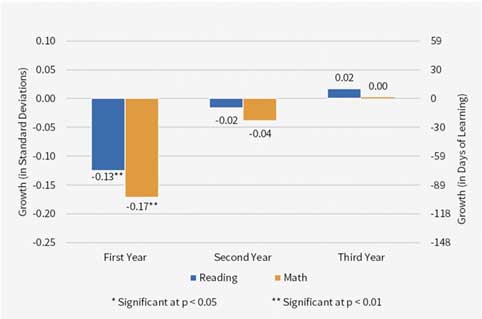The Stanford Center for Research on Education Outcomes (CREDO) report of 2019 measured “Charter School Performance in Pennsylvania.” It has been widely reported that in that report that students who moved from a Traditional Public School (TPS) to a PA Charter School lost ground the first year as compared to their Virtual Control Record (VCR). The Virtual Control Record is an average of 7 similar students that did not attend a Charter School but remained in the Traditional Public School setting.
Unfortunately, largely ignored in that same report is the part that states: “Students in their first year of charter school enrollment experience about 77 fewer days of learning in reading and about 100 fewer days of learning in math compared to the average TPS student. Students in their second or third year of charter school enrollment however perform similarly to the average TPS student in both subjects.”
In other words, within a two-year period, Charter Schools experience, on average, a growth of 100 student days of learning for each student.
The CREDO chart below graphs that dramatic academic growth. Only three years were analyzed. Should this trend continue, Pennsylvania Public Charter Schools would dramatically outpace Traditional Public Schools in academic growth.
The CREDO report tried hard to compare the new student in a Charter School with that student’s “Virtual Control Record (VCR)” in an attempt to compare apples to apples. The first year results for Charter students is “significantly weaker growth.” This means, as the CREDO analysis reports, that students in their first year at a Public Charter School performed significantly worse academically than their “virtual” counterpart who remained in the Traditional Public School. Why is that? There are a number of reasons a student transitioning to a new school might fall behind:
- Students seeking a Public Charter School have powerful reasons for leaving their Traditional Public School. These reasons may not be measurable in a large sampling of students. These reasons might be cultural, safety, family, stress or drug related. A student in an unhealthy or dangerous situation that is looking for a new school might be hard to match to those students that remain in the Traditional School Setting.
- Anytime a student leaves familiar settings and long-time friends, he or she will experience culture shock that requires time to adjust.
- Going from a Traditional Public School setting to a Public Charter School that had higher academic rigor could cause a new student to fall behind and become discouraged.
Given these dynamics, it is not remarkable that a student moving into one of the 187 Pennsylvania Public Charter Schools would do academically worse than his or her “virtual” counterpart in the school left behind. What is truly remarkable is that within two years, that same Charter Student has gained 100 days of academic learning and has surpassed their virtual counterpart in both Math and Reading.
Because of this remarkable growth dynamic, few students leave Public Charter Schools to go back to their Traditional Public School option. On the other hand, 30,000 students submitted more than 120,000 applications to join a Public Charter School through the new Philadelphia School District website in 2019.
These efforts to join one of Philadelphia’s 87 Public Charter Schools demonstrates that parents and students know from experience what the CREDO Report reveals. Transitioning into a Charter School may be an unnerving experience that initially creates poor academic performance but over time, Public Charter Schools help students not only catch up but soar ahead of their peers that remain in their assigned Traditional Public School.


